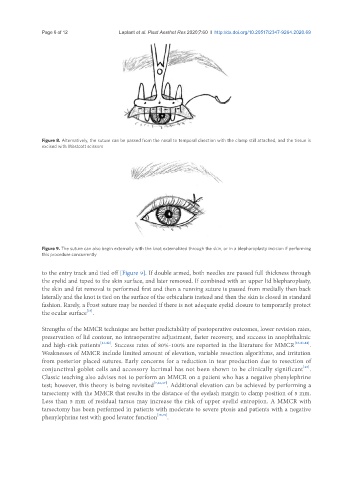Page 706 - Read Online
P. 706
Page 6 of 12 Laplant et al. Plast Aesthet Res 2020;7:60 I http://dx.doi.org/10.20517/2347-9264.2020.69
Figure 8. Alternatively, the suture can be passed from the nasal to temporal direction with the clamp still attached, and the tissue is
excised with Westcott scissors
Figure 9. The suture can also begin externally with the knot externalized through the skin, or in a blepharoplasty incision if performing
this procedure concurrently
to the entry track and tied off [Figure 9]. If double armed, both needles are passed full thickness through
the eyelid and taped to the skin surface, and later removed. If combined with an upper lid blepharoplasty,
the skin and fat removal is performed first and then a running suture is passed from medially then back
laterally and the knot is tied on the surface of the orbicularis instead and then the skin is closed in standard
fashion. Rarely, a Frost suture may be needed if there is not adequate eyelid closure to temporarily protect
[21]
the ocular surface .
Strengths of the MMCR technique are better predictability of postoperative outcomes, lower revision rates,
preservation of lid contour, no intraoperative adjustment, faster recovery, and success in anophthalmic
and high-risk patients [41,42] . Success rates of 80%-100% are reported in the literature for MMCR [33,43,44] .
Weaknesses of MMCR include limited amount of elevation, variable resection algorithms, and irritation
from posterior placed sutures. Early concerns for a reduction in tear production due to resection of
[45]
conjunctival goblet cells and accessory lacrimal has not been shown to be clinically significant .
Classic teaching also advises not to perform an MMCR on a patient who has a negative phenylephrine
test; however, this theory is being revisited [7,46,47] . Additional elevation can be achieved by performing a
tarsectomy with the MMCR that results in the distance of the eyelash margin to clamp position of 5 mm.
Less than 5 mm of residual tarsus may increase the risk of upper eyelid entropion. A MMCR with
tarsectomy has been performed in patients with moderate to severe ptosis and patients with a negative
phenylephrine test with good levator function [48,49] .

